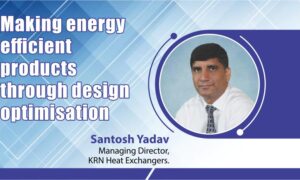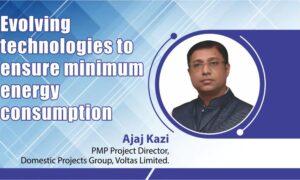Due to overall impact of COVID-19, the business dynamics is expected to change, but we are still left with good 9 months to bounce back, and to regain some of the lost business of April-May.
Neeraj Gupta, Senior General Manager, Living Environment Division, Mitsubishi Electric India
As the COVID-19 pandemic continues its blows on the economy of the country, companies are also seeing a major earnings loss, says Neeraj Gupta, Senior General Manager, Living Environment Division, Mitsubishi Electric India, in an email interview with TCBU.
Mitsubishi Electric is a key player in commercial and residential air-conditioning space. How do you see the opportunity for your HVAC business in Indian green building space?
Mitsubishi Electric commercial and residential air-conditioning systems have earned a global reputation for a higher standard of performance, uncompromising reliability and cost-saving energy efficiency. At the leading-edge of air conditioner innovation, we provide greater comfort to customers while minimising environmental impact. Our USP is offering integrated air conditioning solutions to control indoor air conditions at diverse range of facilities. We believe in customised product development to meet various clients across the globe.
The opportunity for HVAC business in Indian green building space is very big. Our systems are environment friendly, high in efficiency (coefficient of performance – COP), lower energy consumption, highly reliable (less downtime) and a single/ multiple outdoor unit can be used to run multiple indoor units, so less space is required to accommodate the installation of the outdoor units. Thus, providing quiet and comfortable environment.
Could you brief us on the role of HVAC systems in a green building?
HVAC systems play vital role in green buildings since many of the green building factors are affected by the performance of the HVAC systems. The HVAC system for green building shall be planned to reduce energy consumption while maintaining the indoor conditions at a comfortable level to keep occupants’ health and productivity. HVAC system created should not only meet the standard on energy front but beat the standard codes like Energy Conservation Building Codes (ECBC), India and other relevant standards to achieve efficient and higher level of green building rating.
Consequently, any commercial building has the potential to realise significant savings by improving its control of HVAC operations and improving the efficiency of the system it uses. An integrated and comprehensive design process beginning at a project’s planning stage is required to optimise the HVAC design and HVAC commissioning and operation for green buildings.
What are some of the key HVAC solution trends for green buildings?
Following are the trends in HVAC design from thermal comfort strategies to decoupling ventilation from heating and cooling and indirect evaporative cooling:
- Occupant-Based Thermal Comfort Strategies: Systems like radiant cooling help to reduce energy use and improve thermal comfort. Thermal comfort can be directly addressed through other systems such as using low-energy systems to provide localised heating and cooling or by controlling the HVAC system through occupant polling.
- Decoupling of Ventilation and Heating/Cooling: With a DOAS system (What is DOAS), the heating and cooling requirements for space are met through a hydronic system. Since water has a much higher capacity for energy transfer than air, the amount of energy required to deliver the heating and cooling is greatly reduced, while pump energy is somewhat increased. A side benefit of the reduced air quantity is smaller ductwork, which decreases the cost of the ventilation system and, potentially, the building’s required floor-to-floor height. DOAS systems are typically paired with passive chilled beams, radiant heating and cooling, or fan coils.
- Indirect Evaporative Cooling: When it comes to green buildings, owners and architects are striving to meet HVAC loads with optimum comfort and minimal energy. Indirect Evaporative Cooling (IEC) offers a highly efficient way to cool an indoor space without raising the humidity. This system works well when combined with radiant technology for heating and cooling and DOAS for ventilation.
How is the concept of ‘MEQ’ catching up?
MEQ — Mitsubishi Electric Quality results in products at the leading edge of technology. Air conditioners that consume minimal power and protect your investment through a long operational lifespan. Built to take the punishment of extreme weather conditions year in and year out. The following are some of its benefits:
Comfort: Clean air, optimum temperature distribution and silent operation. MEQ has led to the development of state-of-the-art air purification and deodorization filters that remove unwanted odours and impurities in the air. Original airflow technologies and specially designed components provide even temperature distribution — even in remote regions of a room. At Mitsubishi Electric, comfort doesn’t simply mean cool or warm, it means clean and quiet too.
Efficiency: Optimum cost performance and energy savings. MEQ results in air conditioners that are rated among the best in the industry in terms of quality and energy efficiency. We strive for a perfect balance of performance, reliability, low power consumption and long operational life.
Durability: We subject our indoor and outdoor units to rigorous durability testing, including harsher temperature extremes than likely found anywhere in the world. MEQ is behind a mindset that goes to extremes to ensure higher quality products that protect the initial investment over years of reliable service.
Could you tell us more about the impacts of COVID-19 pandemic on HVAC business?
As the COVID-19 pandemic continues its blows on the economy of the country, companies are also seeing a major earnings loss. The country’s air conditioner (AC) manufacturers and suppliers have also been affected. The AC sales are at halt during the peak sales season of summer months in India. The country has already witnessed high to very high temperature in May and June. Though people were inside their homes because of lockdown, service requests have been piling up as it has been the hottest period of the year. There has been a loss of sales, but we are trying our best to provide timely service for our existing customers. We as a responsible and committed partner are ever ready to service our customer needs.
How is your business affected?
Like every other business in the country, there is no business activity for us during the nation-wide lockdown. Due to overall impact of COVID-19, the business dynamics is expected to change, but we are still left with good 9 months to bounce back, and to regain some of the lost business of April-May.
Thanks to our loyal customers, highly efficient and reliable products, good stock availability and efficient service, we could minimise the impact of lockdown and hopefully will recover soon in the coming months.
What are your revival strategies?
We appreciate and believe in the actions taken by the Government of India. HVAC industry can provide extra filters to maintain the clean air which can increase the confidence for the users. Remote operation of essential services like HVAC will be an added advantage for the commercial spaces to gain users confidence.
What are the trends you foresee for HVACR business post-COVID-19 era?
Some of the trends that we can foresee for HVACR business post COVID-19 are online buying as people will be hesitant to venture out especially for the things we can so easily get through the Internet, shifting to high quality highly reliable products to reduce the service team visit to customer premises as human contact will probably still be fearful, increase in warranty terms like up to 10 years for gaining the customer confidence, extension of credit facility through financing companies etc.
Over the past few years a variety of trends have been shaping the HVAC industry that are designed to make systems not only more efficient, but overall more environmentally friendly. More so after the pandemic, systems will be relying on more modern refrigerants, but technology is doing a better job of meeting HVAC needs.
Cookie Consent
We use cookies to personalize your experience. By continuing to visit this website you agree to our Terms & Conditions, Privacy Policy and Cookie Policy.















